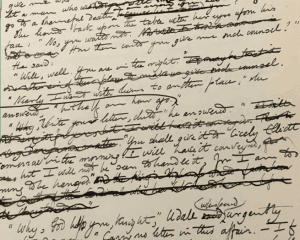By Andrew Gustar

Ford Madox Ford has a somewhat complicated family tree, as illustrated by the trees of his paternal and maternal sides in Max Saunders’ Ford Madox Ford: A Dual Life, Volume 1 (xviii-xix). Another useful (though less accurate) version of the tree can be found online at Geni, which describes itself as the “World Family Tree”. This shows Ford’s parentage through the German Hüffer family and the Madox Browns on his mother’s side, with their link by marriage to the Rossettis. It attempts to depict Ford’s own relationships – with Elsie Martindale, Violet Hunt, Stella Bowen and Jean Rhys – and the resulting offspring, all girls. It also includes Ford’s younger siblings – his brother Oliver and sister Juliet, as well as a mysterious youngest sister, Marie, born around 1881, but with no other details.
Marie does not appear on Saunders’ version of the tree, she is not mentioned in any biography of Ford, and he never refers to her in his memoirs. Perhaps she died young, or for some reason became estranged from the family.
A little further research leads to the likely source – the 1901 UK Census – which shows a Marie Hueffer, aged 20, living at 90 Brook Green, Hammersmith, London, with her mother Catherine Hueffer (aged 48, described as “living on own means”), together with a “boarder”, David Soskice, aged 34 (an “author”, born in “Kief Russia”). Marie is described as a “professional singer”.
These details sound suspiciously like Ford’s sister Juliet. She was born on 20 November 1880, so would have been 20 at the date of the census (31 March 1901). She studied at the Royal College of Music and certainly sang in public concerts. In September 1902 she married David Soskice. Catherine Hueffer was Ford’s widowed mother, his father Franz having died in 1889 when Catherine was just 38.
A search of other genealogical records draws a blank on Marie Hueffer. She cannot be found in the censuses of 1891 or 1911, and nor do there appear to be any records of her birth, marriage or death.
So it seems very likely that the mysterious Marie was actually Juliet Hueffer. Why, though, would Juliet put her name down on the 1901 Census form as Marie?
The census records available today are the books transcribed by local Census Enumerators from the households’ original forms. The details for 90 Brook Green are in the middle of a page covering several adjacent properties, with one line per person, all completed in the same handwriting. The handwritten entry is clearly ‘Marie’ rather than ‘Juliet’, but it is, perhaps, just possible that the enumerator misread the household’s completed form.
Juliet’s middle names were Catherine Emma (after her mother and maternal grandmother), and there is no record of her being known as Marie. Indeed, apart from a few distant German Marias, the whole family tree is strangely devoid of Maries.
One possibility is that Juliet performed as a singer under the name Marie. However, there are press notices of her performing in 1899 as Juliet Hueffer,1 so it seems unlikely that she would subsequently adopt a different stage name after starting to become established. Although Juliet clearly had musical talent – as well as attending the Royal College of Music, there are examples of manuscript compositions by her – it seems likely that she stopped performing in public after her marriage.

One of Juliet’s music manuscripts is signed “Juliet M Hueffer”.2 She later become an author and translator, publishing under the name Juliet M Soskice. The enigmatic middle M (which only ever appears as an initial), if it stood for anything at all, was perhaps most likely for Madox, as appropriated by her older brothers Ford and Oliver, who also often abbreviated it. Or maybe she was sometimes simply known as ‘Em’ – a contraction of her second middle name.
A final possibility is suggested by press reports in February 1902 that David Soskice had been granted a divorce from his wife Anna Sofia on the grounds of her infidelity whilst studying medicine in Paris, where she had gone shortly after they married in September 1899. So David Soskice, boarding with Juliet and Catherine Hueffer, was a married man at the time of the 1901 census, and it appears that the marriage was already in trouble. If there was a spark of attraction between David and Juliet in March 1901, she might have lied about her identity on the census form in order to reduce the risk of subsequent legal or reputational difficulties.
This theory is supported by Anat Vernitski’s observations that by 1898 (i.e. even before David Soskice married Anna) Juliet was learning Russian under Soskice’s influence, and that the couple had fallen in love before Soskice obtained his divorce.3
Whatever the truth about the mysterious Marie Hueffer, Juliet certainly seems to have inherited the family predilection for arbitrary changes of name!
- For example, on page 5 of the “WINDSOR AND ETON EXPRESS; BERKS, BUCKS, SURREY, AND MIDDLESEX JOURNAL; MAIDENHEAD AND SLOUGH GAZETTE” for 14 October 1899, Miss Juliet Hueffer is listed among the performers at “Mr. A. Y. Nutt’s Entertainment” at the Royal Albert Institute, Windsor, the following Tuesday, when “a very excellent programme will be presented” and “there should be a full house.” ↩︎
- See Vernitski, Anat, ‘The Complexity of Truth: Ford and the Russians’, in Ford Madox Ford’s Literary Contacts, ed. Paul Skinner (Amsterdam: Rodopi, 2007), 101–111, p.106. https://doi.org/10.1163/9789401204767_010 ↩︎
- ibid. The evidence is on the reverse of the music manuscript mentioned previously. ↩︎





